History of Japanese Christianity
Christian history in Japan was started when St. Francis Xavier came to Japan as a first Christian
missionary in 1549. Then Christianity was spread in Nagasaki region. However, unparalleled
hidden Cristian history was started from when Toyotomi Hideyoshi Shogunate proclaimed Christian
ban in 1587. During ban on Christianity, people secretly continued to faith while surviving in the
midst of the conventional society and Japanese religions.
Since ban on the Christianity was lifted in 1873, new Christian history in Japan has begun.
1549 St. Francis Xavier came Kagoshima Japan as a first Christian missionary and
commenced the Christian history in Japan
1550 St. Francis Xavier came Hirado as a Christian missionary
1551 Catholic Hirado Church was constructed as first church in Japan
1557 Introduction of Catholicism to Ikitsuki, Kasuga in Hirado
1563 Omura Sumitada, feudral lord of Nagasaki who was first lord convert to Christianity
1569 Todos os Santos Church was constructed as first in Nagasaki by Gaspal Villera
1571 Nagasaki Port was opend to Portugal by feudral lord Omura Sumitada
1580 Arima Harunobu, lord of Arima convert to Christianity and the Seminario was
established in Kuchinotsu as first in Japan
1582 Arima Harunobu teamed up with Kyushu Christian lords Otomo Sorin and ura Sumitada
to dispatch the Tensho Mission to the Pope in Rome
1587 Shogunate, Toyotomi Hideyoshi proclaimed Christian ban
1590 The Tensho Mission retured to Nagasaki
1597 The Twenty-Six Martyrs of Japan, were a group of Catholics who were
executed by crucifixion on February 5 at Nagasaki. Their martyrdom is especially
significant in the history of the Catholic Church in Japan.
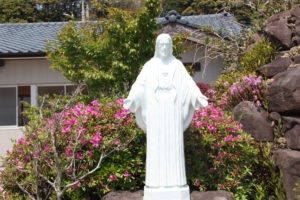 |
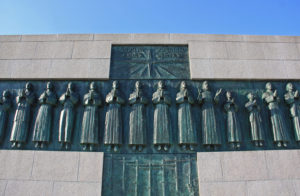 |
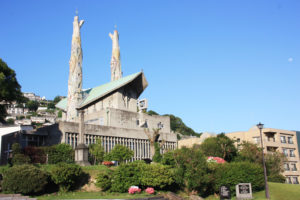 |
1603 Tokugawa Shogunate was established and the natioal isolation policy was applied
1614 The Tokugawa Shogunate prohibited Christianity throughout Japan
1622 five Christians were martyred at Nakae no Shima in Hirado
1624 three Christians were martyred at Nakae no Shima in Hirado
1627 twenty seven Christians were martyred at Unzen Jigoku
1637 Shimabara Rebellion : a peasant uprising against bakufu’s persecution of Christians
under the leadership of Amakusa Shiro
1637 Lorenzo Luiz from Philippines martyred at Nashizaka hill in Nagasaki
1641 Dejima, the small artificial island was opened as Dutch trading port in Nagasaki
1644 Last Christian missionary in Japan is martyred
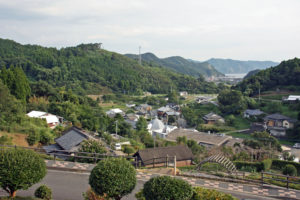 |
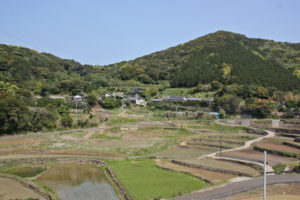 |
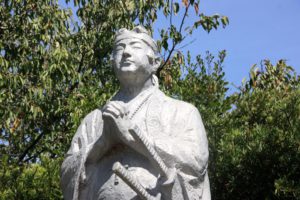 |
1853 Mathew C Perry came to Uraga; the Commodore of the US navy, who played a
significant role in Japanese history, succeeded in opening Japan to foreign countries
1854 Treaty between the USA and Japan : ending the isolation policy and opening the country
1858 Treaty of Amity and Commerce between USA, Netherlands, Russia, England, France and
Japan ; allow religious freedom in foreign residential areas
1862 The 26 Japanese Martyrs at Nishizaka Hill in Nagasaki were canonized by Pope Pius IX.
1865 Oura Cathedral was built as the basilica of Martyrdom of the 26 Saints of Japan
1868 Meiji Restoration, the most important event in Japanese history, which heralded a new era
of modernization in Japan. This revolution restored the imperial rule to Japan after more
than 250years of Tokugawa Shogunate
1873 Ban on the Christianity was lifted
1882 Shitsu Church in Sotome construction started by Father de Rotz’s design
1909 Shitsu Church was completed
1914 Urakami Cathedral construction was completed, it was the largest Catholic church in East Asia
at that time
1912 Yamada Church in Hirado was constructed
1917 Tabira Church in Hirado was constructed
1920 Kurosaki Church was completed by Father de Rotz’s design
1931 St. Francis Xavier Memorial Church in Hirado was constructed at the present location
1945 Atomic bomb dropped in Nagasaki on Aug. 9
The most part of Nagasaki was destroyed, and a tremendous number of lives were lost.
and Urakami Cathedral was completely destroyed.
About 73,000 died instantly, and up to 60,000 were injured.
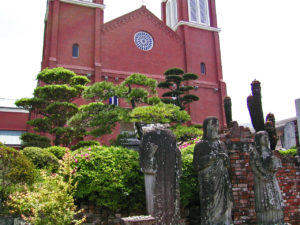 |
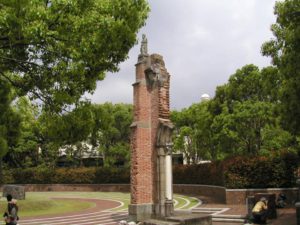 |
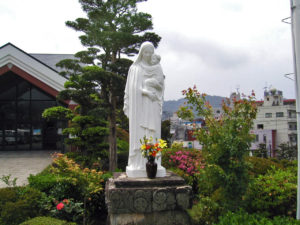 |
1950 Pope Pius XII designated the Nishizaka Hill in Nagasaaki of Martyrdom of 26 Japanese
Saints as an official Pilgrimage site for Catholics
1959 Urakami Cathedral replacement was built
1981 Pope John Paul II visited in Nagasaki
1982 Saint Teresa of Calcutta commonly known as Mother Teresa visited in Nagasaki
1987 Saint Lorenzo Ruiz was canonized by the same pope in the Vatican city on 18 October,
making him the first Filipino Saint
2000 Ebdo Shusaku ( novelist of Silence ) Literary Museum is opened in Sotome
2018 Hidden Christian site is registered on UNESCO’s World Heritage
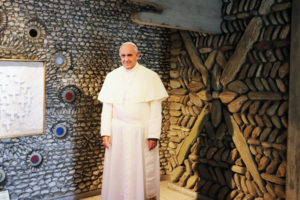 |
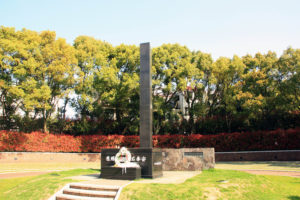 |
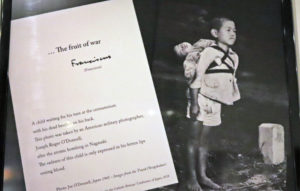 |
2019 Pope Francis visited Nagasaki on Nov.24 and and calls for a ‘world without Nuclear
Weapons’ at the Ground Zero.
Home Our Services Tailor-made guided tour Christian Pilgrimage tour Golf tour
Kyushu Travel Guide Kyushu Photo Collection Off the beaten path What our Customers have to say
Nagasaki was a small Rome in 1569
Todos os Santos Church, the first church in Nagasaki, was built in 1569.
Federal lord Omura and the Jesuits made an agreement to make Nagasaki
a port for trade with Nanban. (Portugal and Spain) in 1570.
Nagasaki Port was opened and the first Portuguese ship arrived in 1571.
And development of the town of cape was started as Christian town in 1571
and the small Church of San Paulo was constructed at the tip of cape.
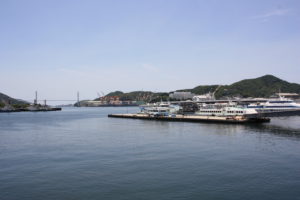 |
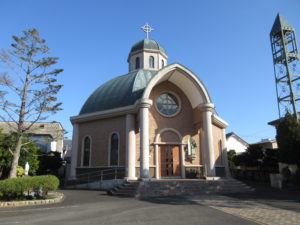 |
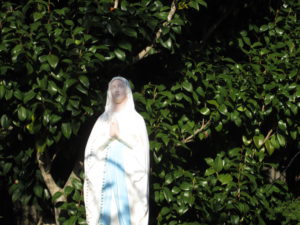 |
After that following Churches were constructed.
Misericordia Headquarters Church in 1583
Santa Maria Church in 1600
Santa Clara Church in 1603
Santiago Church in 1604
San Juan Petista Church in 1605
San Antonio Church in 1606
San Pedro Church in 1607
San Francisco Church in 1611
San Agustin Church in 1612
For 45 years after the first church was built, Nagasaki developed as a Christian town,
and by 1614, most of the 25,000 people were Christians.
It was as if Nagasaki was a small Rome.
However, due to the Tokugawa Shogunate’s Ban on Christianity in 1614, most of the
church buildings were destroyed within 15 days from November 3rd.
Opening the port created Christian town Nagasaki in 1570
Nagasaki Port was opened in 1570 by Sumitada Omura, who was the first feudal lord
in Japan to be baptized as a Christian.
At that time, there was a Christian family who immigrated with Figueiredo.
Many of them were people fleeing persecution, coming from Shimabara, Iki, Goto,
Hirado, and Yamaguchi. This was the beginning of the Christian town Nagasaki.
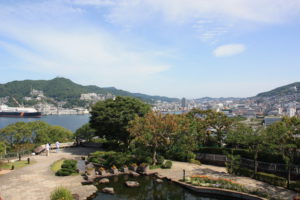 |
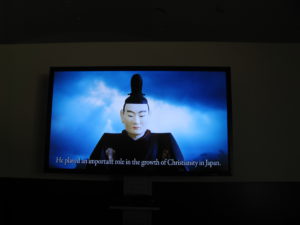 |
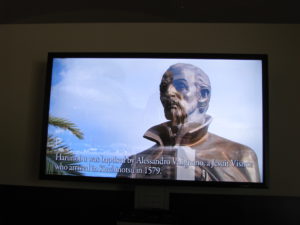 |
Sumitada Omura donated the territories of Nagasaki and Mogi to the Jesuits in order
to fend off attacks from nearby enemies.
In 1580, Japan Society of Jesus established its headquarters in Nagasaki.
Tensho youth mission to Europe in 1582
In 1582, four youth boarded a ship bound for Europe at Nagasaki Port.
They were dispatched as representatives of Japanese Christian federal lords,
and departed with Alessandro Valignano who was Jesuit missionary who
planned the Youth mission.
Four youth were Ito Mansho Ito, Chijiwa Miguel, Hara Martino, Nakaura Julian
who were around 13 years old.
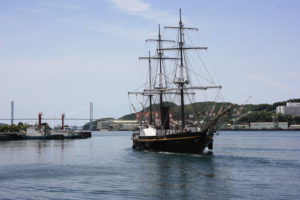 |
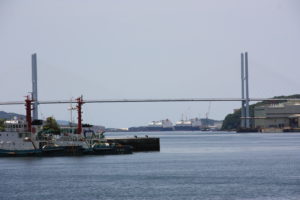 |
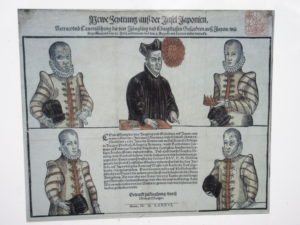 |
The purpose of the mission is to show the four people who studied at Arima
Seminario about Europe and to convey the greatness of Europe to the
Japanese people.
By introducing the boy raised by the Jesuits to Europe, the mission was to
highlight the achievements of Japan’s missionary work and gain support from
the Pope and the King of Portugal.
Two years and six months after leaving Nagasaki, they finally arrived in Europe.
He first had an audience with Philip II at Rispon, and was subsequently welcomed
in various places.
On March 23, 1585, Japan had an audience with the Pope and made its grand d
ebut on the world stage. After that, they also visited various parts of Italy.
When they returned to Nagasaki in 1590, Christianity was being prohibited.
Therefore, their achievements were suppressed due to the ban on Christianity.
It was not until 1858, when religious freedom was recognized, that their activities
were evaluated.
26 Saints were the first martyrs in Japan in 1597
26 Christians arrested in Kyoto who were consisted of 20 Japanese, 4 Spaniards,
1 Mexican, and 1 Portuguese.
They were forced to walk barefoot to Nagasaki for about a month.
On February 5, 1597, all 26 Christians arrived at Nishizaka and were tied to Crosses.
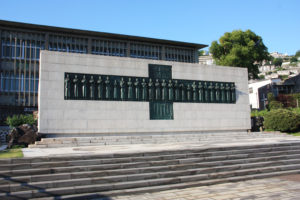 |
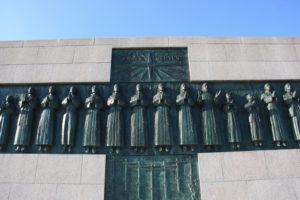 |
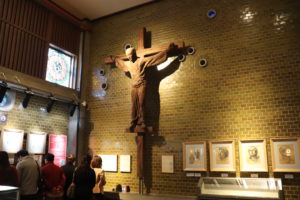 |
Paul Miki said from the Cross
All of you who are here, please listen to me.
I did not com from the Philippines, I am a Japanese by birth, and a brother of the Society
of Jesus.
I have committed no crime, and the only reason why I am put to death is that I have been
teaching the doctrine of our Lord Jesus Christ.
I am very happy to die for such cause, and see my death as great blessing from the Lord.
At this critical time, when you can rest assured that I will not try to deceive you, I want to stress
and make it unmistakably clear that man can find no way to salvation other than the Christian
way. The Christian law commands that we forgive our enemies and who have wronged us.
I must therefore say here that I forgive Taikosama (Hideyoshi).
I would rather have all the Japanese become Christians.
(From Luis Frois’s Martyrs Records, 1597)
Santo Domingo Church, built in 1609
Santo Domingo Church was built in 1609 by Dominican Father Francisco de Morales
in Nagasaki after demolishing a church in Kagoshima.
However, five years later, the church was destroyed due to the ban on Christianity.
 |
 |
 |
The ruins of this church were discovered in 2002 during an excavation survey conducted
in conjunction with the rebuilding of the Sakuramachi Elementary School building.
Now, the Santo Domingo Church Ruins Museum was established. Excavated artifacts, ruins,
and Christian-related materials discovered in Nagasaki are on display.
Ban on Christianity in 1612
The number of Christians in Japan continued to increase, and reaching 300,000 in 1614.
Fearing the ever-increasing number of Christian rebellions, Tokugawa Shogunate finally
issued a ban on Christianity in Nagasaki in 1612, and two years later in 1614 throughout
the country in Japan.
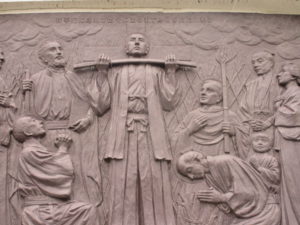 |
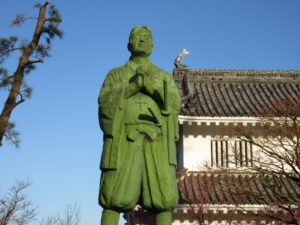 |
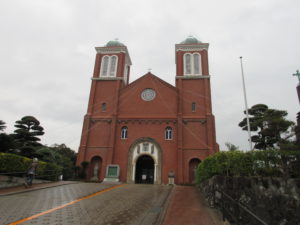 |
After that, the history of martyrdom began in various places.
・in 1617, 4 missionaries were martyred in Omura
・in 1622, Genna great martyrdom (55 Christians) at Nishizaka
・in 1622-24, Ikutsuki and Nakae-no-shima island martyrdom
・from 1627, Unzen jigoku martyrdom
・1633, Nakaura Julian martyred in Nishizaka
・in 1637, Shimabara Rebellion
・in 1644, Konishi Manjo martyrdom, Domestic priests become absent
・in 1657, Persecution of Christians in Omura
・in 1790, Persecution of Christians in Urakami
・in 1839, Persecution of Christians in Urakami
・in 1856, Persecution of Christians in Urakami
Hidden Christians from 1612
Oppression against Christians began with the Tokugawa shogunate’s ban
on Christianity. The missionaries were expelled to oversea countries, and
those who remained secretly in Japan were also captured and martyred.
Konishi Mansho who was the last Priest during the ban on Christianity,
was also martyred in 1644.
In the absence of priests, believers pretended to be Shinto or Buddhist
ostensibly in order to protect their faith.
The Christian organizations were created in each village to continue the
Christian faith and the faith was passed down from parents to children and
from children to grandchildren.
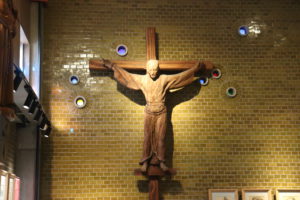 |
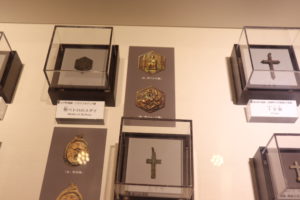 |
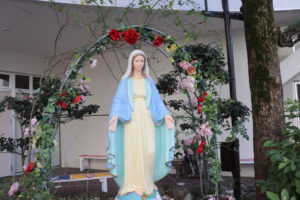 |
Hidden Christian
Even after lifted ban on Christianity, people who continue to practice their
faith in the same way as before are called “Hidden Christians”.
Hidden Christians in Nagasaki have been passed down since the ban on
Christianity in Hirado, Ikitsuki, the Goto Islands, Sotome, and around Nagasaki.
Genna great Martyrdom in 1622
25 years after the martyrdom of the 26 Saints, the blood of Christians was shed
once again at Nishizaka in Nagasaki.
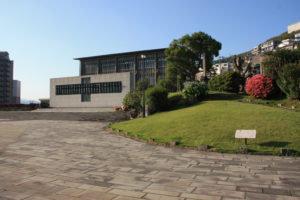 |
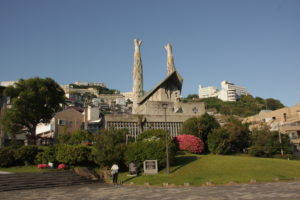 |
55 Christians were martyred who were arrested at Suzuta Prison in Omura and
Kurusu Prison in Nagasaki.
These included Italian missionary Carlo Spinola and Portuguese missionary
Domingos Jorge.
Unzen jigoku Martyrdom from 1626
When Matsukura Shigemasa became the new federal lord of Shimabara in 1616,
many people were Christians. Initially, he acquiesced in Christianity, because
he needed people’s cooperation to build Shimabara Castle.
However, this situation was known to Tokugawa Shogunate, and he strongly
commanded Christians in Shimabara to convert.
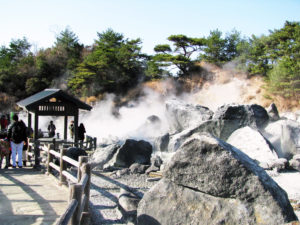 |
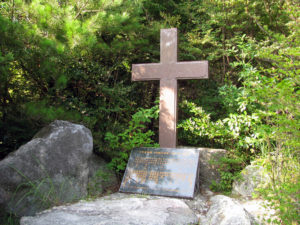 |
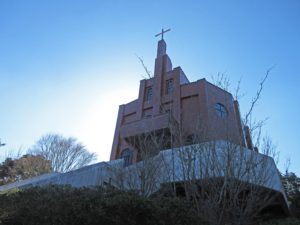 |
From 1627, Christians who did not convert were persecuted using the boiling water
of Unzen jigoku.
Many Christians were taken to this Unzen jigoku and martyred.
Unzen Church is dedicated to Father Antonio Ishida, a martyr of Unzen Hell, and
martyrdom festival is held every May.
Unzen jigoku is a tourist spot in Unzen.
Jigoku, means Hell, is the number one attraction of Unzen with a peculiar smell of sulfur
emitted from the springs, and boiled hot water and white smoke rising from the ground
over a wide area. This is a striking reminder that Unzen Volcano is still very much alive.
